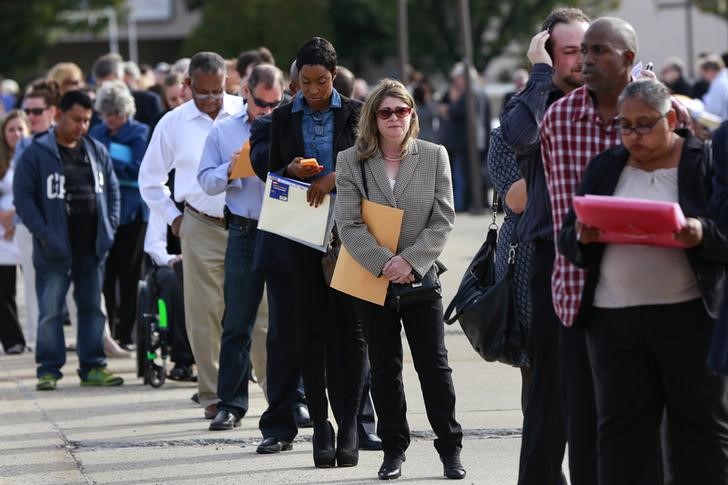By Lucia Mutikani
WASHINGTON (Reuters) - New U.S. applications for unemployment benefits last week recorded their largest increase in eight months, but remained at levels consistent with a fairly healthy labor market.
Other data on Thursday showed a surprise rise in productivity in the third quarter after a drop in self-employment led to overall hours worked falling for the first time in six years, restraining labor-related production costs.
Initial claims for state unemployment benefits increased 16,000 to a seasonally adjusted 276,000 for the week ended Oct.31, the Labor Department said. It was the largest weekly increase since late February.
Still, last week marked the 35th straight week that claims were below the 300,000 threshold normally associated with a strong jobs market. Claims had hovered near 42-year lows for much of October.
"There is no evidence that there has been a pickup in involuntary job separations and we continue to expect an increase of 200,000 in private payrolls in October," said John Ryding, chief economist at RDQ Economics in New York.
The four-week moving average of claims, considered a better measure of labor market trends as it strips out week-to-week volatility, rose 3,500 to 262,750 last week.
Last week's claims report has no bearing on the October employment report due for release on Friday. According to a Reuters survey of economists, nonfarm payrolls rose 180,000 in October, well above the average gain of 139,000 jobs for August and September. The unemployment rate is forecast at 5.1 percent.
Solid payroll gains in October could seal the case for a December interest rate increase from the Federal Reserve.
The claims report showed the number of people still receiving benefits after an initial week of aid increased 17,000 to 2.16 million in the week ended Oct. 24. The four-week moving average of continuing claims, however, fell to the lowest level since November 2000.
The trend in continuing claims suggests more long-term unemployed are finding work, consistent with a low jobless rate.
The dollar was little changed against a basket of currencies, while price for U.S. Treasuries fell. Stocks on Wall Street were trading lower.
WEAK PRODUCTIVITY TREND
In a second report, the Labor Department said productivity, which measures hourly output per worker, increased at a 1.6 percent annual rate after advancing at an upwardly revised 3.5 percent rate in the second quarter.
Manufacturing productivity grew at its fastest pace in four years, led by the durable goods sector. Economists had expected productivity to contract at a 0.2 percent rate in the July-September quarter after expanding at a previously reported 3.3 percent pace in the second quarter.
Despite the surprise rise in the third quarter, the trend in productivity remained weak. Productivity increased only 0.4 percent from the same period last year. That was a slowdown from 0.8 percent in the second quarter.
Economists blame softer productivity on a lack of investment, which they say has led to an unprecedented fall in capital intensity.
"The nature of much tech investment these days may not be doing much to help productivity. Mobile apps that make it easier to waste time at work may be leisure enhancing, but they don't support labor productivity," said Ted Wieseman, an economist at Morgan Stanley (N:MS) in New York.
While weak productivity has boosted employment growth as companies hired more workers to increase output, it has contributed to stagnant wages and lowered the economy's speed limit. Persistently anemic productivity could continue to limit wage growth even as the labor market approaches full employment.
In the third quarter, hours worked declined at a 0.5 percent rate, the first drop since the third quarter of 2009. That reflected a fall in self-employment as well as adjustments to hours for nonprofit and government enterprise workers.
Unit labor costs, the price of labor per single unit of output, increased at a 1.4 percent rate in the third quarter after dropping at a 1.8 percent rate in the prior quarter. Unit labor costs rose 2.0 percent compared to last year.
Economists say a tightening labor market could boost productivity as employers seek to cut production-related costs.

"As qualified labor is becoming scarce and the unemployment rate has now reached a level that historically has been associated with building wage pressures, firms may be more motivated to invest in labor-saving equipment that could lead to an acceleration in output per hour," said Kevin Cummins (N:CMI), a senior economist at RBS (L:RBS) in Stamford, Connecticut.